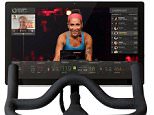Researchers reveal the mechanics of running is simpler than thought - and it could revolutionise shoe design
- Have always used multi-mass springs model to explain mechanics of running
- New study finds a two-mass model that could personalized running shoes
- Pattern of force on the ground is due to the motion of two parts of the body
- Lower portion of the connecting leg and the the rest of the body
A study has found a new explanation for the basic mechanics of human running.
While observing Olympic-caliber sprinters, researchers discovered that a runner's pattern of force application on the ground is due to the motion of just two parts of the body: the contacting leg and the rest of the body.
The new approach could help create new patterns to optimize the design of running shoes, orthoses and prosthetics, as experts are able to see exactly how a person runs.
Scroll down for videos
A study has discovered a new explanation the basic mechanics of human running. Using a two-mass model, researchers found that a runner's pattern of force application on the ground is due to the motion of two parts of the body: the contacting leg and the rest of the body
The Southern Methodist University (SMU) researchers explained that the basic concept of their 'two-mass model' is relatively simple - a runner's pattern of force application on the ground is due to the motion of two parts of the body: the lower portion of the leg that is contacting the ground, and the sum total of the rest of the body.
The force contributions of the two body parts are each predicted from their largely independent motions when they have foot-ground contact.
And then combined to predict the overall pattern.
The final prediction relies only upon classical physics and a characteristic link between the force and motion for the two body parts.
'Our model inputs are limited to contact time on the ground, time in the air, and the motion of the ankle or lower limb.
'From three basic stride variables we are able to predict the full pattern of ground-force application,' said Laurence Ryan, who is a physicist and research engineer at SMU's Locomotor Performance Laboratory.
'The approach opens up inexpensive ways to predict the ground reaction forces and tissue loading rates.'
'Runners and other athletes can know the answer to the critical functional question of how they are contacting and applying force to the ground.'
Prior to this study, experts relied on a different explanation for the physics of running.
Called the multi-mass springs model, this explanation was developed to evaluate rear-foot impacts at jogging speeds and only predict the early portion of the force pattern.
But this method was not as clearly linked to the body as the latest findings propose.
The multi-mass springs model divides the body into four or more masses and includes other variables that are hard to link to the actual parts of a human body.
'The human body is mechanically complex, but our new study indicates that the pattern of force on the ground can be accurately understood from the motion of just two body parts,' said Clark, first author on the study and currently an assistant professor in the Department of Kinesiology at West Chester University in West Chester, Pennsylvania.
'The foot and the lower leg stop abruptly upon impact, and the rest of the body above the knee moves in a characteristic way,' Kenneth Clark said.
'This new simplified approach makes it possible to predict the entire pattern of force on the ground - from impact to toe-off - with very basic motion data.'
The force contributions of the two body parts are each predicted from their largely independent, respective motions during the foot-ground contact period. The two force contributions are then combined to predict the overall pattern
Prior to this research, experts could only use in-ground force platforms or force treadmills to study human running.
And it has always been difficult to reduce to basic and accurate explanations of an athlete's body parts and ground forces.
'From both a running performance and injury risk standpoint, many investigations over the last 15 years have focused on the link between limb motion and force application,' said Weyand, who is the director of SMU's Locomotor Performance Laboratory.
'We're excited that this research can shed light on this basic relationship.'
The team discovered this new model while observing the impact forces from Olympic-caliber sprinters.
The team discovered this new model while observing the impact forces from Olympic-caliber sprinters. Pictured is another Olypic sprinter, Usain Bolt of Jamaica, as he competes on Day 9 of the Rio 2016 Olympic Games
'The world-class sprinters gave us a big signal to figure out the critical determinants of the shape of the waveform,' said Weyand.
'Without their big impact forces, we would probably have not been able to recognize that the ground-force patterns of all runners, regardless of their foot-strike mechanics and running speed, have two basic parts.'
When the researchers first began to analyze the complicated force waveform signals, they found that they were actually composed of two very simple overlapping waveforms, Ryan said.
'Our computer generated the best pattern predictions when the timing of the first waveform coincided with the high-speed video of the ankle stopping on impact. This was true to within a millisecond, every single time. And we did it hundreds of times,' he said. 'So we knew we had a direct physical relationship between force and motion that provided a critical insight.'
The SMU team's new concise waveforms potentially have diagnostic possibilities, Weyand said.
For example, a runner's pre-injury waveforms could be compared to their post-injury and post-rehab waveforms.
'You could potentially identify the asymmetries of runners with tibial stress fractures, Achilles tendonitis or other injuries by comparing the force patterns of their injured and healthy legs,' he said.
And while medical images could suggest the injury has healed, their waveforms might tell a different story.
'The waveform patterns might show the athlete continues to run with less force on the injured limb, Weyand said.
So it may offer an inexpensive diagnostic tool that was not previously available.'
Most watched News videos
- Moment carer is caught on camera manhandling a dementia patient
- Ministry of Defence release build up to Marine A shooting Taliban fighter
- Woman filmed performing sex act in Florida court house
- Sky News presenter accidentally says 'pr**k' in Trump segment
- MoD video shows build-up to moment marine shoots Taliban fighter
- Ivanka posts video of Arabella singing a song for Chinese New Year
- Moments after Audi R8 GT crashes after driving almost 200 mph
- John Berocw says there's 'no issue' with baby being in commons
- Man hanging from windowsill of high flat falls to his death
- 'I'd like you to apologise': Moment outraged caller phones LBC
- Junkie holds young girl at knifepoint as he demands drugs from police
- Loose Women: Farage rows with Saira Khan over US travel ban
-
 EXCLUSIVE: Trump's Supreme Court pick Neil Gorsuch...
EXCLUSIVE: Trump's Supreme Court pick Neil Gorsuch... -
 Brought to tears by Sharia justice: Woman is forced to...
Brought to tears by Sharia justice: Woman is forced to... -
 Woman gives birth to 'FROG' baby in Zimbabwe… and is made...
Woman gives birth to 'FROG' baby in Zimbabwe… and is made... -
 EXCLUSIVE: With frostbite on her hands and hair frozen to...
EXCLUSIVE: With frostbite on her hands and hair frozen to... -
 'WAKE UP & JOIN THE RESISTANCE': Sarah Silverman calls...
'WAKE UP & JOIN THE RESISTANCE': Sarah Silverman calls... -
 Bupa carer is caught on hidden camera manhandling...
Bupa carer is caught on hidden camera manhandling... -
 Mother reveals daughter, 13, 'was relentlessly bullied at...
Mother reveals daughter, 13, 'was relentlessly bullied at... -
 Rotherham child sex gang shout 'Allahu Akbar' in court as...
Rotherham child sex gang shout 'Allahu Akbar' in court as... -
 EXCLUSIVE PHOTOS Home sweet home! Neighbors welcome the...
EXCLUSIVE PHOTOS Home sweet home! Neighbors welcome the... -
 Anna Nicole's daughter Dannielynn shows off her wonderful...
Anna Nicole's daughter Dannielynn shows off her wonderful... -
 Russian girl, 12, is raped by family friend before being...
Russian girl, 12, is raped by family friend before being... -
 Revealed: Never-before-seen footage of a dramatic Apache...
Revealed: Never-before-seen footage of a dramatic Apache...









 Your comment will be credited to your MailOnline persona
Your comment will be credited to your MailOnline persona































































































































































































































































 Saturn's icy rings up close: Stunning Cassini images reveal bruised and battered surface
Saturn's icy rings up close: Stunning Cassini images reveal bruised and battered surface